I don't have 2 animated GIFs of the same length, so I'll just use two copies of this one:

Let's look at the frames in there, with this:
identify 1.gif
1.gif[0] GIF 500x339 500x339+0+0 8-bit sRGB 32c 508KB 0.000u 0:00.000
1.gif[1] GIF 449x339 500x339+51+0 8-bit sRGB 32c 508KB 0.000u 0:00.000
1.gif[2] GIF 449x339 500x339+51+0 8-bit sRGB 32c 508KB 0.000u 0:00.000
1.gif[3] GIF 449x339 500x339+51+0 8-bit sRGB 32c 508KB 0.000u 0:00.000
1.gif[4] GIF 448x339 500x339+52+0 8-bit sRGB 32c 508KB 0.000u 0:00.000
1.gif[5] GIF 449x339 500x339+51+0 8-bit sRGB 32c 508KB 0.000u 0:00.000
1.gif[6] GIF 448x339 500x339+52+0 8-bit sRGB 32c 508KB 0.000u 0:00.000
1.gif[7] GIF 448x339 500x339+52+0 8-bit sRGB 32c 508KB 0.000u 0:00.000
1.gif[8] GIF 448x339 500x339+52+0 8-bit sRGB 32c 508KB 0.000u 0:00.000
1.gif[9] GIF 448x339 500x339+52+0 8-bit sRGB 32c 508KB 0.000u 0:00.000
1.gif[10] GIF 448x339 500x339+52+0 8-bit sRGB 32c 508KB 0.000u 0:00.000
1.gif[11] GIF 500x339 500x339+0+0 8-bit sRGB 32c 508KB 0.000u 0:00.000
1.gif[12] GIF 500x339 500x339+0+0 8-bit sRGB 32c 508KB 0.000u 0:00.000
1.gif[13] GIF 500x339 500x339+0+0 8-bit sRGB 32c 508KB 0.000u 0:00.000
1.gif[14] GIF 500x339 500x339+0+0 8-bit sRGB 32c 508KB 0.000u 0:00.000
1.gif[15] GIF 448x339 500x339+52+0 8-bit sRGB 32c 508KB 0.000u 0:00.000
1.gif[16] GIF 500x339 500x339+0+0 8-bit sRGB 32c 508KB 0.000u 0:00.000
1.gif[17] GIF 500x339 500x339+0+0 8-bit sRGB 32c 508KB 0.000u 0:00.000
Mmmm, 18 frames with different sizes, that means we need to use -coalesce to rebuild partial frames into full ones.
Let's copy that and make 2.gif
cp 1.gif 2.gif
Now we can split the two gifs into their component frames, like this:
convert 1.gif -coalesce a-%04d.gif # split frames of 1.gif into a-0001.gif, a-0002.gif etc
convert 2.gif -coalesce b-%04d.gif # split frames of 2.gif into b-0001.gif, b-0002.gif etc
Now let's join the individual frames side-by-side:
for f in a-*.gif; do convert $f ${f/a/b} +append $f; done
Note that ${f/a/b} is a bash-ism meaning "take the value of f and replace the letter 'a' with 'b'".
And put them back together again:
convert -loop 0 -delay 20 a-*.gif result.gif
That looks longer, and harder, than it is because I tried to explain it all, but it looks like this really:
convert 1.gif -coalesce a-%04d.gif # separate frames of 1.gif
convert 2.gif -coalesce b-%04d.gif # separate frames of 2.gif
for f in a-*.gif; do convert $f ${f/a/b} +append $f; done # append frames side-by-side
convert -loop 0 -delay 20 a-*.gif result.gif # rejoin frames

Note that this conceptual code, not production quality. It doesn't remove the temporary files it creates, nor does it carry the inter-frame time forward from the original GIFs. If you want to get the original frame rate you could get them like this and save them into an array and feed the delays back into the re-animation command at the end:
identify -format "%f[%s] %T\n" 1.gif
1.gif[0] 8
1.gif[1] 8
1.gif[2] 8
1.gif[3] 8
1.gif[4] 8
1.gif[5] 8
1.gif[6] 8
1.gif[7] 8
1.gif[8] 8
1.gif[9] 8
1.gif[10] 11
1.gif[11] 11
1.gif[12] 11
1.gif[13] 11
1.gif[14] 11
1.gif[15] 11
1.gif[16] 11
1.gif[17] 26
Also, you may want a spacer between the two animations, say 10 pixels, which you can do by replacing the convert command inside the for loop with this one:
convert $f -size 10x xc:none ${f/a/b} +append $f



